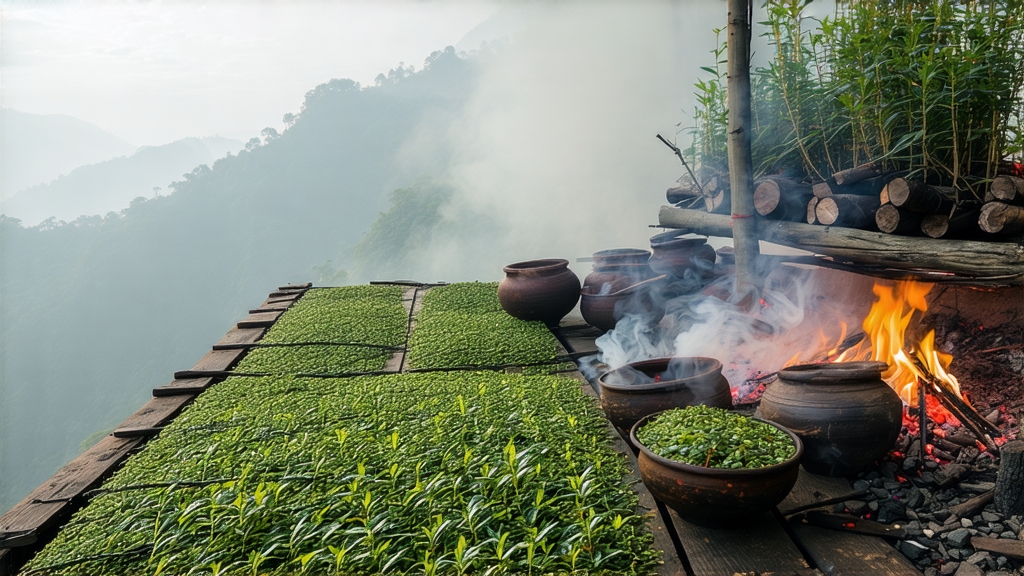
Long before English merchants coined the word “black tea,” Chinese tea masters in the Wuyi Mountains of northern Fujian had already perfected a leaf so bold that it would travel the globe and inspire every future variety of fully oxidized tea. Locals called it Zheng Shan Xiao Zhong—“original mountain small leaf”—but the world came to know it as Lapsang Souchong, the primal campfire aroma that once perfumed the parlors of London and the courts of St. Petersburg. Today, while newer black teas compete for brightness or sweetness, Lapsang Souchong remains a living fossil of flavor, carrying within its curled, pitch-black leaves the story of how smoke, copper, and pine transformed Chinese tea into an international language.
History: From Ming Border Guards to London Coffeehouses
The accepted chronology places Lapsang’s birth in the late Ming dynasty, around 1604, when Qing troop movements cut off the usual tea caravan routes. Faced with surplus leaf and imminent spoilage, Tongmu village farmers hastily dried their harvest over fresh pine fires so it could survive the longer trek to the port of Xiamen. The accidental smoke infusion proved addictive; Dutch traders bought the entire lot, and by 1640 the tea reached Amsterdam, where it was rebranded “bohea” (from the Min-dialect pronunciation of Wuyi). When Catherine of Braganza brought a chest to Charles II’s court in 1662, pine-smoked black tea became the fashionable antidote to London’s fog, cementing Britain’s centuries-long obsession with strong, dark liquor. Thus, every modern black tea—from Assam CTC to Keemun—descends from this serendipitous moment when necessity and pine resin collided.
Terroir: Why Only Tongmu Can Birth True Zheng Shan
The Wuyi range is a UNESCO biosphere reserve where granitic cliffs force cool, moist air to linger in narrow gorges. At 1,200 m elevation, Tongmu village sits inside a natural amphitheater wrapped by evergreen forests of Masson pine and Chinese fir. The diurnal swing of 15 °C slows leaf growth, concentrating amino acids, while the resinous vapor from surrounding trees becomes the invisible seasoning absorbed by the tea. Chinese law now designates 680 hectares as the authentic “core origin”; any leaf picked outside this radius may be labeled “Lapsang” for export, but connoisseurs know the difference between genuine Tongmu and the commodity smoke-flavored teas of neighboring counties.
Cultivars: Three Faces of the Same Leaf
Within the protected zone, three closely related cultivars dominate. Cai Cha (“vegetable tea”), a seed-propagated landrace, yields the most traditional pine-smoke character—tarred, almost medicinal, with a longan-sweet finish. Xiao Ye Zhong (“small leaf”), a clonal selection, gives a softer, honeyed cup preferred by newer Chinese drinkers. Finally, Ye Sheng (“wild”) bushes, scattered among bamboo groves, produce tiny, insect-bitten leaves that ferment unpredictably, creating layers of cacao, pipe tobacco, and camphor. Each cultivar is harvested only in the five-day window before Grain Rain, when the leaf’s catechals are primed for oxidation yet still tender enough to twist into tight hooks.
Craft: Smoke as Timekeeper
Unlike generic smoked teas that are merely flavored after firing, authentic Lapsang Souchong is smoked while still pliant, allowing the resin to bond with oxidizing polyphenols. The process begins at dusk: baskets of withered leaves are loaded into a second-floor loft of a three-hundred-year-old fir-wood house. Below, a pinewood fire is kept at 80 °C for six hours; the smoke, filtered through a bamboo lattice, rises and curls around the leaf, depositing guaiacol and syringol—the same phenols that lend Islay whiskies their peaty soul. At dawn the leaves are rolled on rattan mats, oxidizing rapidly in the humid mountain air until they turn the color of rusted iron. A second, shorter smoking follows, then charcoal roasting in iron woks at 200 °C for ninety seconds, just long enough to seal the aroma without baking the sweetness away. The entire choreography is timed by the master’s nose: when the scent shifts from raw pine to toasted caramel, the tea is finished.
Grades: Souchong vs. Pekoe vs. Bo